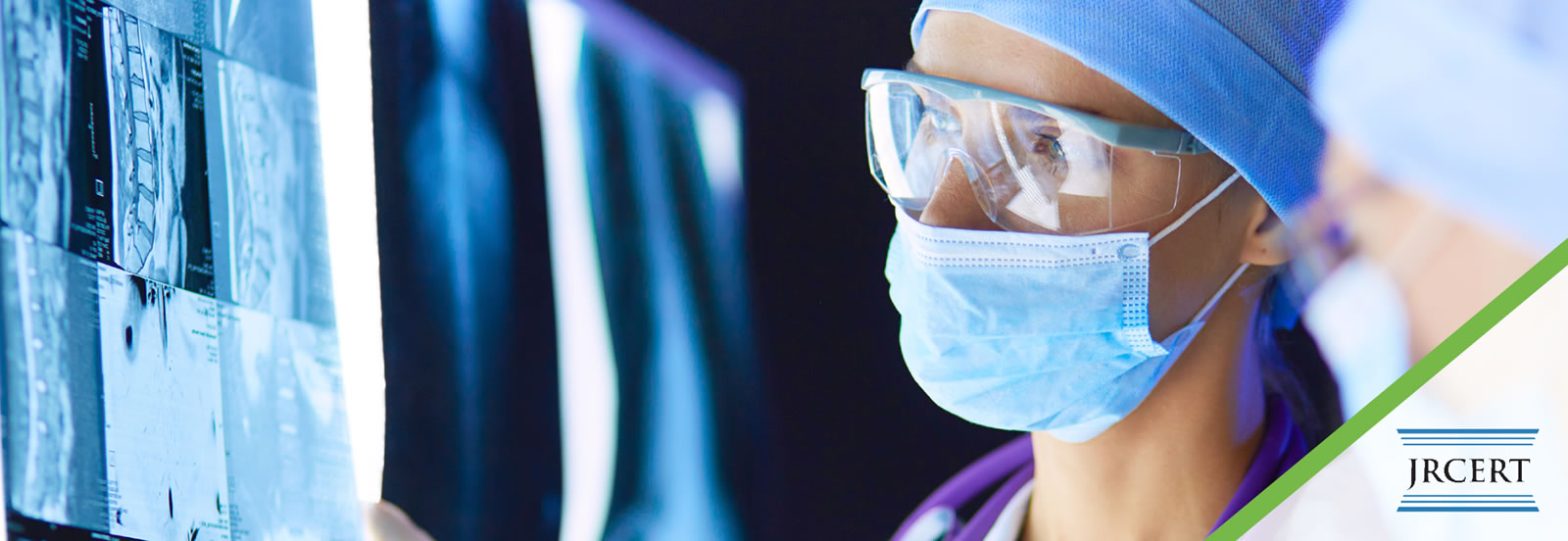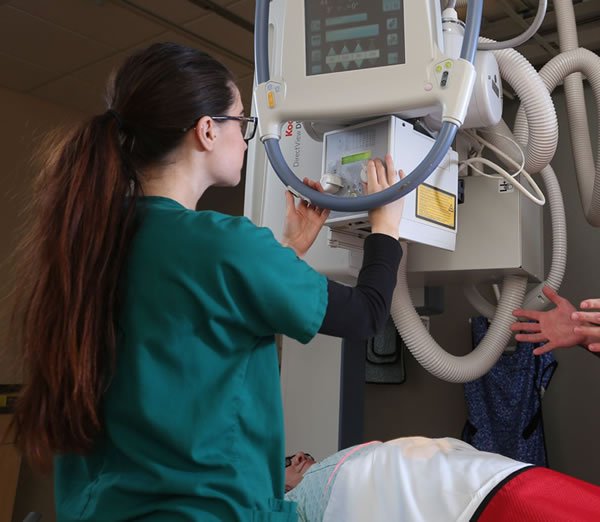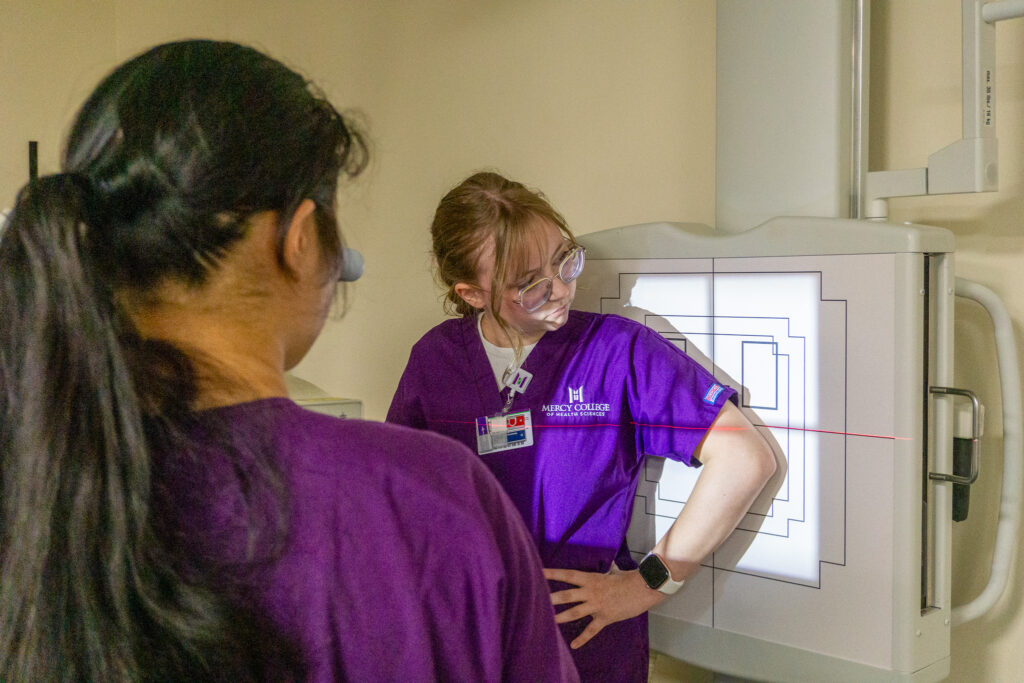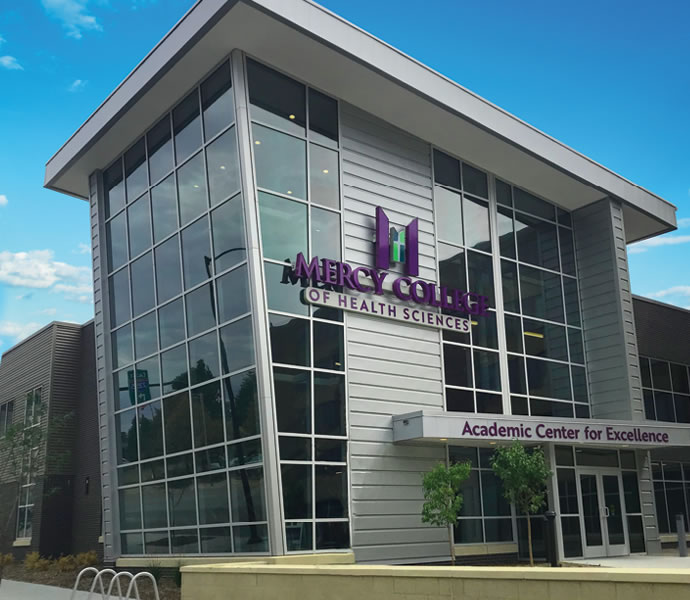Radiologic Technology

CHART YOUR COURSE
BECOME A RADIOGRAPHER
As a radiologic technologist (radiographer), you’ll use sophisticated imaging equipment and ionizing radiation to obtain medical images of the body. After completing our hybrid Associate of Science in Radiologic Technology from Mercy College of Health Sciences, you will perform imaging examinations to diagnose and treat illness and injury alongside physicians and other healthcare providers. Your work may take place in a hospital or clinic.
Median Wage1
Licensure Exam Pass Rate (2020-2024)
Employment Rate Within 6 Months of Passing the Licensure Exam
Program Completion Rate (2024)
Projected Job Growth from 2019 – 20291
Our body of work
ABOUT OUR RADIOLOGIC TECHNOLOGY MAJOR
Our six-semester hybrid Associate of Science in Radiologic Technology has one start date in the summer and includes classroom instruction, practice in a skills lab, and clinical experiences in medical imaging. You’ll learn the art and science of medical imaging by studying liberal arts and science courses alongside your hospital and clinical-based professional education. Through this exceptional program, you’ll acquire the knowledge, skills, and attitudes needed to care for patients and safely use state-of-the-art X-ray equipment.
PROGRAM FORMAT
- Coursework: 100% asynchronous online
- Skills Labs: In-person at Mercy College in Des Moines, Iowa
Summer: Tuesday & Wednesday 9:00 – 11:15 am
Fall: Tuesday & Wednesday 9:00 – 12:00 pm
Spring: Tuesday & Thursday 9:00 – 10:50 am - Clinicals: Hands-on experiences across central Iowa
Application Deadline: January 1
ACCREDITED BY THE JOINT REVIEW COMMITTEE ON EDUCATION IN RADIOLOGIC TECHNOLOGY (JRCERT)
The radiologic technology program is accredited by Joint Review Committee on Education in Radiologic Technology (JRCERT), 20 N Wacker Dr, Ste. 2850, Chicago, IL 60606-3182; (312) 704-5300; email: mail@jrcert.org.
The program’s current award is 8 years. General program accreditation information and the current accreditation award letter can be found at Mercy College of Health Sciences – JRCERT.
JRCERT accreditation status dates:
+ 2010 (8 years)
+ 2018 (8 years)
+ 2021 (5 years)
+ 2023 (8 years)
Our radiologic technology faculty team includes a full-time program chair and a clinical coordinator, as well as many medical professionals in clinical settings. Our full-time liberal arts and science faculty members are PhD-prepared and adept at integrating their subject matters into a comprehensive health science curriculum. As a student, you will receive an exceptional level of personalized instruction from experienced educators dedicated to your success.
English isn’t my parents’ first language, but everyone at Mercy College went above and beyond to make sure we understood the admissions and financial aid processes. The hands-on learning opportunities in my classes have been a huge help in preparing me for my licensure exams and setting me on my path to a successful career.
Irma S., Diagnostic Medical Sonography and Healthcare Administration Candidate, 2021

STEP ONE: COLLEGE ADMISSION
To be considered for admission to the Associate of Science in Radiologic Technology major, you must first be admitted to Mercy College of Health Sciences. Learn more about admission to Mercy College. Complete our online Mercy College application. Early application is encouraged. Once admitted to Mercy College of Health Sciences, you may enroll in Core requirements prior to your admission to any academic major. If you are transferring credits, please visit our transfer page to learn more.
STEP TWO: PROGRAM ADMISSION
To be considered for admission to the Radiologic Technology major, you must meet the following requirements:
- Earn a cumulative GPA of 2.7 on high school transcripts
- Minimum ACT composite score of 20 or higher
- Demonstrate completion of one year of high school with a GPA of at least a 2.0 (C, not C-) on a 4.0 scale in:
- Algebra I
- Algebra II
- Biology
- Earn a cumulative GPA of 2.7 or higher on a 4.0 scale in a minimum of nine (9) college credits from the last college attended
Articulation of Transfer Credit to Radiologic Technology
Applicants meeting admissions criteria who have completed radiologic technology courses at another institution may apply for transfer credit. The courses considered for transfer must have been completed no more than two years prior to the semester in which the student enrolls in the radiologic technology sequence at Mercy College. Courses considered for transfer must be completed at an accredited institution that also has program accreditation. The following will be considered in the approval of transfer credit:
- Similarity of course content.
- Placement exams will be administered by the Program Chair to verify knowledge and clinical skills prior to accepting transfer credit.
- Evaluation of clinical competency by Mercy College faculty.
- Availability of space in the appropriate radiologic technology course.
- Transfer credits applied must have a grade of “C” or higher (not C-“).
Applicants who meet the above requirements for first-time college and transfer students will be invited via email to attend a mandatory information session detailing further program admission requirements. A short writing assignment will also be required of each applicant.
The following courses are required to earn your Associate of Science in Radiologic Technology.
Semester 1 (Summer)
RAD 101 – Foundations of Radiologic Imaging (2 cr)
RAD 104 – Principles of Radiologic Imaging (2 cr)
RAD 110 – Applied Radiography I (3 cr)
Semester 2 (Fall)
BIO 180* – Human Anatomy w/Lab (4 cr)
ENG 101 – English Composition I (3 cr)
RAD 111 – Clinical Practicum I (2 cr)
RAD 114 – Principles of Radiologic Imaging II (2 cr)
RAD 120 – Applied Radiography II (3 cr)
SVL 285 – Servant Leadership (3 cr)
Semester 3 (Spring)
BIO 185* – Human Physiology w/Lab (4 cr)
ENG 102 – English Composition II (3 cr)
RAD 116 – Imaging Systems (3 cr)
RAD 121 – Clinical Practicum II (2 cr)
RAD 130 – Applied Radiography III (2 cr)
SOC 1xx – Social Science Elective (3 cr)
Semester 4 (Summer)
RAD 131 – Clinical Practicum III (5 cr)
SPE 105 – Small Group Communication (3 cr)
Semester 5 (Fall)
RAD 202 – Pathology (2 cr)
RAD 203 – Advanced Pt. Care (3 cr)
RAD 205 – Radiation Physics (3 cr)
RAD 210 – Applied Radiography IV (2 cr)
RAD 211 – Clinical Practicum IV (3 cr)
Semester 6 (Spring)
RAD 215 – Radiation Biology (3 cr)
RAD 220 – Applied Radiography V (3 cr)
RAD 221 – Clinical Practicum V (3 cr)
*Can be completed ahead of time, in the recommended semester, or at a later time.
TOTAL: 78 CREDITS FOR ASSOCIATE DEGREE
The Radiologic Technology major offers one start date per year in the summer. View our full academic calendar for exact semester start dates. Pre-requisites and Core requirements may be completed at Mercy College of Health Sciences year-round.
OUTCOMES†
|
Program Completion Rate |
Licensure Examination Pass Rate |
Employment rate within 1 year following graduation |
|---|---|---|
Program Completion Rate 89% |
Licensure Examination Pass Rate 80% |
Employment rate within 1 year following graduation 100% |
Institution Name: Mercy College of Health Sciences
Program Type: Radiography Program
Degree Type: Associate of Science
Program Effectiveness Data
The following is the most current program effectiveness data. Our programmatic accreditation agency, the Joint Review Committee on Education in Radiologic Technology (JRCERT), defines and publishes this information. The information can be found directly on the JRCERT webpage.
Credentialing Examination
The number of students who pass, on the first attempt, the American Registry of Radiologic Technologists (ARRT) certification examination, or an unrestricted state licensing examination, compared with the number of graduates who take the examination within six months of graduation. The five-year average benchmark established by the JRCERT is 75%.
| Credentialing Examination Rate | Number passed on first attempt divided by number attempted within 6 months of graduation |
| YEAR | RESULTS |
| Year 1 – 2021 | 6 of 9 = 66.7% |
| Year 2 – 2022 | 6 of 8 = 75% |
| Year 3 – 2023 | 7 of 8 = 88% |
| Year 4 – 2024 | 10 of 10 = 100% |
| Year 5 – 2025 | 6 of 8 = 75% |
| Program 5-year average | 35 of 43 = 81.4% |
Job Placement
The number of graduates employed in the radiologic sciences compared to the number of graduates actively seeking employment in the radiologic sciences within twelve months of graduating. The JRCERT has defined “not actively seeking employment” as: 1) Graduate fails to communicate with program officials regarding employment status after multiple attempts OR 2) Graduate is unwilling to seek employment that requires relocation, OR 3) Graduate is unwilling to accept employment due to salary or hours, OR 4) Graduate is on active military duty, OR 5) Graduate is continuing education. The five-year average benchmark established by the JRCERT is 75%.
| Job Placement Rate | Number employed divided by number actively seeking employment within 12 months of graduation. |
| Year | Results |
| Year 1 – 2021 | 7 of 7 = 100% |
| Year 2 – 2022 | 7 of 7 = 100% |
| Year 3 – 2023 | 7 of 7 = 100% |
| Year 4 – 2024 | 10 of 10 = 100% |
| Year 5 – 2025 | 8 of 8 = 100% |
| Program 5-Year Average | 39 of 39 = 100% |
Program Completion
If a student leaves the program for the following reasons he/she should NOT be counted as attrition. The reasons are financial, medical/mental health, family reasons. Military deployment. Change in academic major. Any reason sponsoring institution deems nonacademic withdrawal.
| Program Completion Rate | Number graduated divided by number started the program |
| Year | Results |
| Year 1 – 2024 | 10 of 10 = 100% |
| Annual Completion Rate | 100% |
Mission Statement:
Guided by the mission of Mercy College, the philosophy of the Allied Health programs, and in compliance with the Joint Review Committee on Education in Radiologic Technology, the primary purpose is to facilitate the personal and professional development of students.
Therefore, the program provides the knowledge, skills, and attitudes needed to care for the sick and injured, produce quality diagnostic images, protect self and others from unnecessary radiation exposure, and pursue life-long learning.
Goals:
1. Educate students to be effective communicators
Student Learning Outcomes – students will be able to
- Effectively communicate through oral methods
- Effectively communicate through written methods
2. Educate students to be effective critical thinkers and problem solvers
Student Learning Outcomes – students should be able to
- Provide appropriate care in response to emergency/trauma situations
- Accurately evaluate radiographic images
3. Educate students to be technically skilled in order to provide quality patient care while protecting patients, self, and others from unnecessary ionizing radiation.
Student Learning Outcomes – students will be able to
- Accurately manipulate radiographic equipment
- Accurately position patients
- Correctly set radiographic techniques
- Correctly use radiation protection methods
- Provide quality patient care
4. Encourage students in their professional development and pursuit of life-long learning
Student Learning Outcomes – students will be able to
- Develop a Personal Philosophy on professionalism
- Demonstrate professional behaviors in the clinical arena
5. Meet the needs of the community
Student Learning Outcomes
- Students entering the program will complete the program
- Graduates who take the ARRT National Board Examination within six months of graduation will pass on the first attempt.
- Graduates will be satisfied with the educational program
- Employers will hire graduates
- Of those seeking employment in radiology, graduates will be employed within six months of graduation




